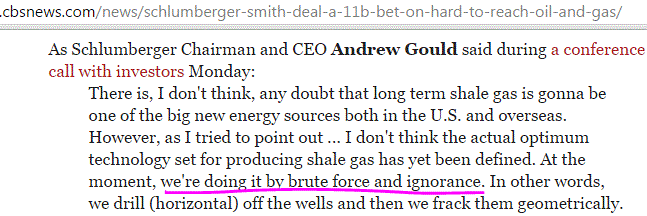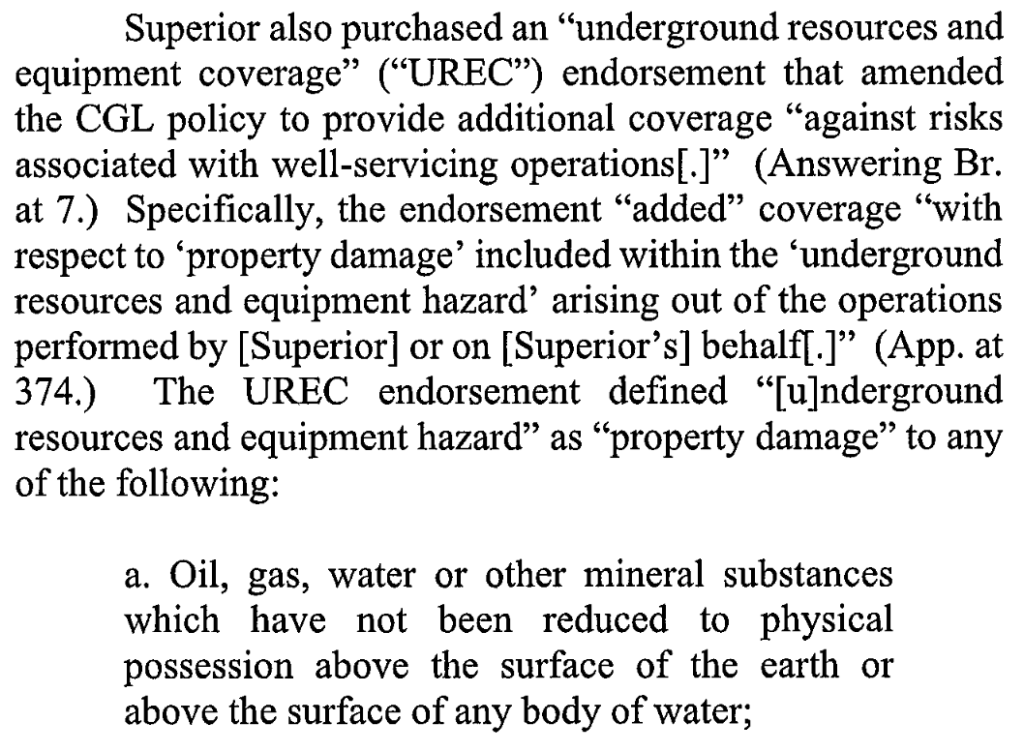
Accidental frac’ing?
Frac’ers intentionally experiment with different chemical brews intentionally using “brute force and ignorance” intentionally contaminating millions of gallons of water to intentionally cause damage underground (often contaminating aquifers and water wells in their violent stupid intentional process).

Trigger warning for the frac harmed (notably those abadoned by companies, regulators and courts): The ruling is a good but galling read.
Hydraulic Fracking Services/Commercial General Liability Policy: Federal Appellate Court Addresses Coverage for Faulty Workmanship by Mitchell, Williams, Selig, Gates & Woodyard, P.L.L.C. and Jenna Davidson, June 23, 2023
The United States Court of Appeals for the Third Circuit (“Appellate Court”) addressed in a May 31st Opinion an insurance coverage question arising out of hydraulic fracking services being employed to extract natural gas. See American Home Insurance Co. v. Superior Well Services, Inc., No. 22-1498.
The issue addressed was whether certain Commercial General Liability (“CGL”) policies provided coverage to a contractor that allegedly damaged certain wells through faulty workmanship.
U.S. Energy Development Corporation (“U.S. Energy”) alleged that Superior Well Services, Inc. (“Superior”) damaged 97 of its wells through its improper use of certain chemical mixtures during fracking.
Fracking fluid contains different chemicals for different purposes such as dissolving minerals, eliminating bacteria, and slowing corrosion. The United States Environmental Protection Agency (“EPA”) has previously identified over 1,084 chemicals present in fracking fluids.
States typically require disclosure of chemicals.

However, exclusions are sometimes provided for “confidential business information” (“CBI”). A focus of the CBI may be the chemical identity. U.S. EPA, Hydraulic Fracturing for Oil and Gas. Dec. 2016, at 16, https://www.epa.gov/sites/default/files/2016-12/documents/hfdwa_executive_summary.pdf.
A jury awarded U.S. Energy $6.16 million![]() the ruling says that increased to $13.18 million after the state court tabulated and added in interest
the ruling says that increased to $13.18 million after the state court tabulated and added in interest![]() in May 2018 after determining that Superior had damaged 53 of the 97 wells. This was deemed a breach of contract.
in May 2018 after determining that Superior had damaged 53 of the 97 wells. This was deemed a breach of contract.
Superior held CGL policies from American Home. An Underground Resources and Equipment Coverage (“UREC”) endorsement had also been obtained which amended the CGLs. This endorsement added coverage with respect to property damage associated with well-servicing operations.

Above snap from the ruling
American Home sought a declaratory judgment that it was not required to indemnify (i.e., provide coverage) for any damages awarded to U.S .Energy. It argued that property damage caused by a failure to perform a contract “in a workman like manner” is not an “occurrence” under the policy. The contract defined “occurrence” as “an accident…” but it did not define “accident.”
U.S. energy intervened as a defendant arguing that the plain text of the endorsement expressly covered the judgment.
The District Court also considered whether the 53 damaged wells were each a separate occurrence or a single occurrence. It concluded that each damaged well constituted a separate occurrence. This triggered an independent coverage limit for each well.
Summary judgment was granted in favor of Superior and U.S. Energy. The term “occurrence” was held to cause “failing to perform a contract in a workman like manner” distinguishing the language from “faulty workmanship.” The Pennsylvania Supreme Court had previously held that the term “occurrence” does not cover “faulty workmanship.”
The Appellate Court reversed. It held that Superior’s use of an unsuitable product that resulted in damage did not constitute an “occurrence” because the insurance policy defined it as an “accident.”
Precedential cases (Kvaerner and Sapa) were cited that indicated poor workmanship is too “foreseeable to be considered an accident.” An accident was described as unexpected or occurring unintentionally. This was held to not coincide with faulty workmanship. The Appellate Court opined that the phrases “faulty workmanship” and “failure to perform in a workman like manner” are equivalent in this case.
The Appellate Court also analyzed how the UREC endorsement impacted the underlying CGL. It concluded that they are best read together, were not in conflict, and incorporated the “occurrence” requirement through the “property damage” requirement. It did not reach the question regarding the 53 separate occurrences since there was no occurrence.
The case was reversed and remanded with directions to enter judgment for American Home.
A copy of the Opinion can be downloaded here.
